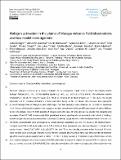Browsing Facultad de Ciencias de la Tierra y el Mar by Author "Saballos, Armando"
Now showing items 1-2 of 2
-
Halogen activation in the plume of Masaya volcano: field observations and box model investigations
Rüdiger, Julian; Gutmann, Alexandra; Bobrowski, Nicole; Liotta, Marcello; De Moor, J. Maarten; Sander, Rolf; Dinger, Florian; Tirpitz, Jan-Lukas; Ibarra, Martha; Saballos, Armando; Martínez, María; Mendoza, Elvis; Ferrufino, Arnoldo; Stix, John; Valdés, Juan; Castro, Jonathan M.; Hoffmann, Thorsten (Atmospheric Chemistry and Physics, 2020)Volcanic emissions are a source of halogens to the atmosphere. Rapid reactions convert the initially emitted hydrogen halides (HCl, HBr, HI) into reactive species e.g. BrO, Br2, BrCl, ClO, OClO and IO. The activation ... -
Mechanisms of Unrest and Eruption at Persistently Restless Volcanoes: Insights From the 2015 Eruption of Telica Volcano, Nicaragua
Roman, Diana C.; Bussard, Rebecca; Higgins, Machel; Feineman, Maureen; de Moor, Joost Maarten; Saballos, Armando; Ibarra, Martha; Strauch, Wilfried; Tenorio, Virginia; LaFemina, Peter; Stephens, Kirsten; Wauthier, Christelle; Arellano, Santiago; Avard, Geoffroy; Martínez Cruz, María; Burton, Michael; Varnam, Matthew (Advancing Earh and Space Science, 2019)Many of Earth's volcanoes experience well‐defined states of “quiescence” and “unrest,” with unrest occasionally culminating in eruption. Some volcanoes, however, experience an unusually protracted (i.e., decades‐long) ...

